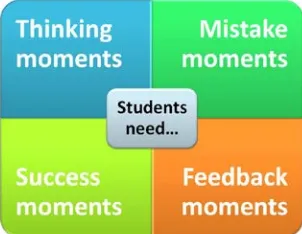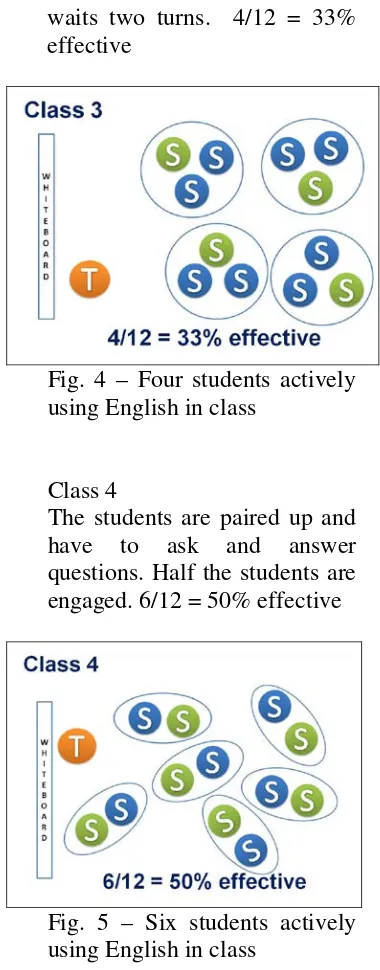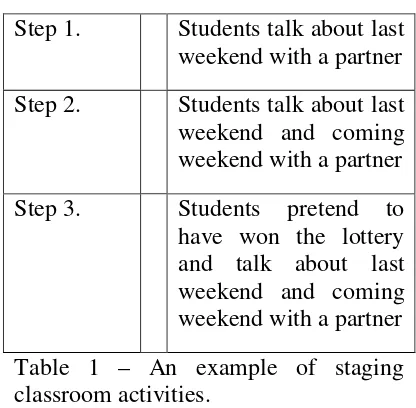Seminar Nasional ISBN:978-602-96839-5-0 Pendidikan Fisika dan Bahasa Inggris 2014
Ing 3- 1
ACTIVITY LOGISTICS WITHIN THE ENGLISH CLASSROOM
by Gaby Schilders Spikap! training & development Darmahusada Indah Barat AB105 – Surabaya
gaby@spikap.web.id
Abstract: Activity logistics means doing classroom activities in such a way that all students have optimal opportunities to practice. They also have a certain amount of control over what they are doing and therefore gain more motivation to learn.
Language classes often focus too heavily on the teacher and the verbally strong students. As educators, we are responsible for teaching all students and using Activity logistics can accomplish that.
Approach
With Activity logistics, we can simply calculate how effective an activity is. In a class of 12 students:
1. The teacher asks one student a question => One student answers and 11 students wait for their turn. 1/12 = 8% effective.
2. Two students write sentences on the board => 10 students wait, each student waits 5 turns. 2/12= 16% effective.
3. The students play a board game in groups of 3, each student waits two turns. 4/12 = 33% effective
4. The students are paired up and have to ask and answer questions. Half the students are engaged. 6/12 = 50% effective
Results
The teacher can measure how effective the activity is. Conclusions
When students get more practice, they gain confidence in using English and their language skills improve.
Keywords: Activity logistics, effective, include all students
Introduction
The materials discussed in this paper are what I have been practicing in my teacher trainings for Preschool, Kindergarten, Elementary and English language school teachers in Surabaya and Sidoarjo for the past five years. I saw that many teachers teach in a very traditional way, copying the way that they had been taught themselves when they were young. When observing teachers and students in a class, I often concluded that the teacher works too hard and that the students are often waiting for the teacher or their turn, or are sitting and listening to explanations of language points.
The interaction in classes is mainly between the teacher and the verbally strong students. Teachers are, however,
responsible for teaching all the students in the class and this includes the talkative, quiet, weak, strong, average, active and other students.
I believe that the roles in the class should be the other way around to create a situation where the students are actively using their English as much as possible. The role of the teacher changes to that of a facilitator or you could say a manager. They manage the class but do not actually do the work. They delegate.
Ing 3- 2 Fig. 1 – What students need in order to
learn
• Thinking moments
Students need practice, their brain needs to be active. Copying the teacher does not engage the brain and students should be engaged in activities where they have to find their own answers and solve their own problems. The teacher should guide the students.
• Mistake moments
Students need to be made aware that making mistakes is a vital part of the learning process. In
my experience, students can
be afraid to make mistakes and therefore copy from friends or wait
for confirmation from the
teacher before actually writing
down answers. When there is
an atmosphere where it accepted to make mistakes, students will
take more risks in their
learning and venture out of
their comfort zone.
• Success moments
All students need to experience success. If we only look at the end result, it will be very difficult to see success. Instead of aiming for the final goal, we have to see all progress as success. This way, we see the
success in small steps and are motivated to continue to the next step.
• Feedback moments
Unless students ask questions themselves, we give most of the feedback after the activity. The teacher focuses his or her attention on three to five mistakes that he or she has heard during the activity.
Method
In order for language learning to be more effective in the classroom, the teacher should change the way she conducts the activities in the class. The role of the teacher as well as the students will change. The teacher will facilitate and oversee more as opposed to managing and presenting activities and being in charge all the time. Since the students have to work in their own groups, they are responsible for arranging their own activity and have to solve any upcoming problems, with or without help from the teacher.
We will start with the role of the students. In traditional classrooms, the students spend a lot of time sitting down, listening to the teacher and following instructions. During activities, the teacher often asks one student to come and write a sentence or the class is divided into 2 big groups to play a game. Students spend a lot of their class time waiting for their turn.
Seminar Nasional ISBN:978-602-96839-5-0 Pendidikan Fisika dan Bahasa Inggris 2014
Ing 3- 3 In order to do this, we have to
rearrange the way we do activities in the classroom and I have called it Activity logistics.
Using Activity logistics, we can simply calculate how effective an activity is. In a class of 12 students:
Class 1
The teacher asks one student a question => One student answers and 11 students wait for their turn. 1/12 = 8% effective.
Fig. 2 – One student actively using English in class
Class 2
Two students write sentences on the board => 10 students wait, each student waits 5 turns. 2/12= 16% effective.
Fig. 3 – Two students actively using English in class
Class 3
The students play a board game in groups of 3, each student
waits two turns. 4/12 = 33% effective
Fig. 4 – Four students actively using English in class
Class 4
The students are paired up and have to ask and answer questions. Half the students are engaged. 6/12 = 50% effective
Fig. 5 – Six students actively using English in class
When activities are done like A or B, the students spend much time waiting for their turn and will not learn much during the activity. When using C or D, students are actively engaged in the activity and learning is taking place. They are also responsible, within their small group or pair, for their own learning.
Ing 3- 4 traditional classrooms, the teacher
gives instructions, on language points and on activities and often interrupt students who make mistakes.
The interaction in the class is mainly between the teacher and the verbally strong students, since they are eager to respond. The weaker and shy students sit back and listen. They do not produce, unless the teacher directly asks them.
Difficulties when introducing Activity logistics.
Teachers might agree that Activity Logistics can be implemented in their classroom. When they try it out in their classes, they will see that at first, it takes a lot of time to arrange the class and students into small groups and pairs. The students might not know what is expected of them, they might not be used to working without supervision of the teacher. The teacher might find it difficult to step back and not interrupt the students. The students and teacher will get used to this new method after a few lessons and the students will get used to being more active
Staging classroom activities
In order for Activity logistics to work even better, the teachers can stage the activities. The first round they play, they start of simple. The second round, they add more vocabulary or expand on the target language. The third round, they add another something extra to the mix so that the students keep an interest in the activity and materials.
Staging classroom activities
Step 1. Students talk about last
weekend with a partner
Step 2. Students talk about last
weekend and coming weekend with a partner
Step 3. Students pretend to
have won the lottery and talk about last weekend and coming weekend with a partner
Table 1 – An example of staging classroom activities.
Conclusion
Teachers are able to use Activity logistics without supervision and can calculate how effective an activity is. Students will use more English during their lesson which will contribute to their self confidence in using English. The role of the teacher changes and teachers manage the class instead of control it.
References
Cuppers, F. 2012 The six fases of an instruction lesson
www.onderwijs maakjesamen.nl/.../Zes-Fases-+-COOP-structuren.pdf
Harmer, J. 2012 Essential Teacher Knowledge: Core concepts in English language Teaching Pearson


